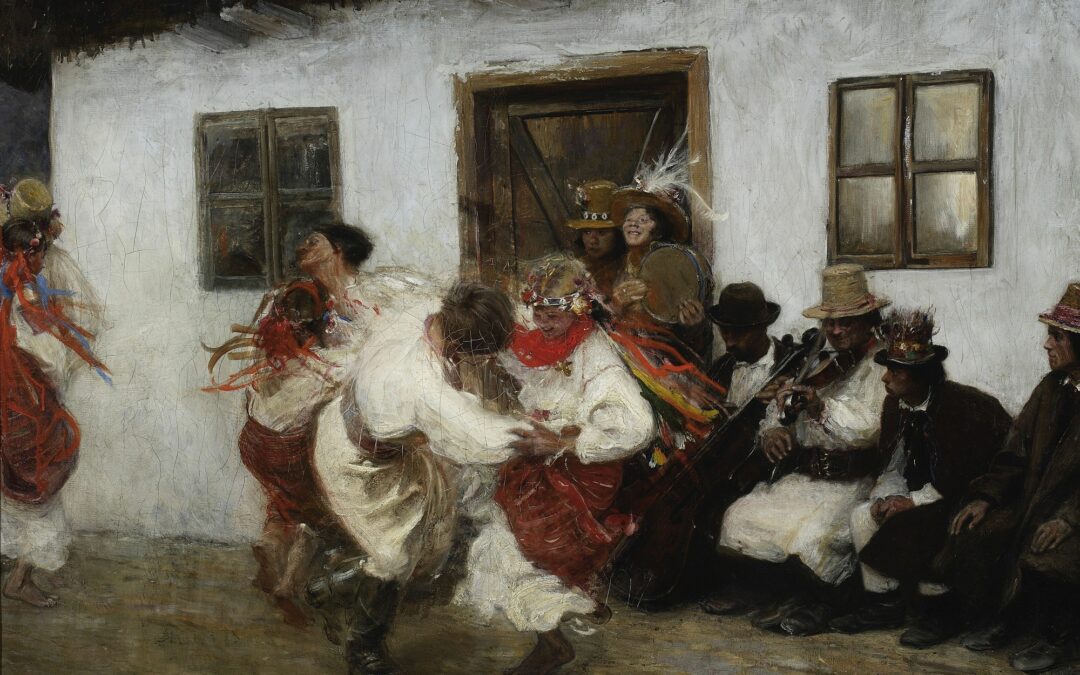By Aleksandra Janiszewska
The 19th century was an extremely difficult time for Poland to develop and maintain its national identity. The country had formally ceased to exist in 1795, when it was divided between imperial Russia, Prussia and the Habsburg monarchy (today’s Austria) in an event known as the third partition.
Over the following decades, the partition shaped the approach of Polish artists, starting from the Romantics, who expressed their patriotic attitudes and the need to preserve Polish identity.
It was in literature and art that the “historicity” and roots of the dismembered community were sought, preserving a sense of connection but also creating something of a national mythology.

Constitution of May 3, 1791 by Jan Matejko, 1891 (National Museum of Poland/public domain)
The experience of loss of self-rule and subordination to the imperial forces was common to the lands of East Central Europe and Scandinavia. The art produced in these countries tried to emphasise national features in each of the various cultures. Cosmopolitan trends and styles were perceived as an additional danger to building national identity.
This was why the artists associated with the national movement wanted to distinguish themselves from the international style of Art Nouveau, as well as academicism and historicism in architecture. In their view, folk culture offered a treasure trove of local individuality and tradition unchanged for centuries. National styles were constructed on the basis of local folk culture and traditions.
The exhibition Polish National Styles 1890–1918 at the National Museum in Kraków recalls the final stage in this development of Polish art, which took place in the period leading up to Poland regaining its independence.
Several national styles developed in Poland, mostly reflected in architecture. Among these was the Vistulian-Baltic style, the tenets of which were formed in the 1860s and ‘70s. It alluded to the Gothic style and sprang from a belief that architecture in the Polish lands should be reborn on the basis of a native variant of medieval trends.
This resulted in the building of neo-Gothic churches mainly in Congress Poland – the name given to the Russian partition – which today form a common part of the Polish landscape.
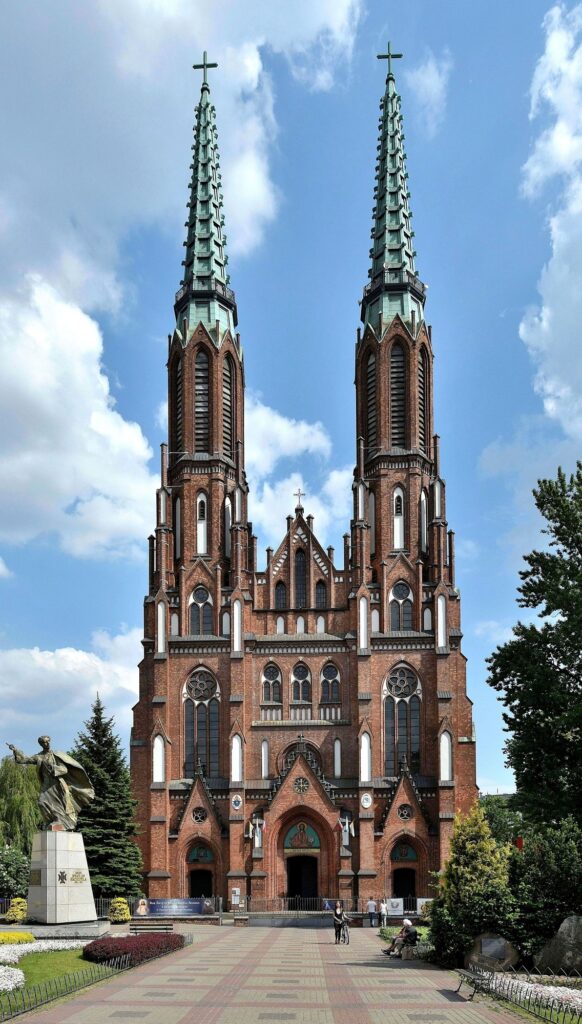
The neo-Gothic turn-of-the-century St Florian’s Cathedral in Warsaw (photo: Adrian Grycuk/Wikimedia, under CC BY-SA 3.0)
Another type was the vernacular/National-Romantic style (styl swojski), geared towards ideas of nativeness combined with forms of modern architecture, especially in church designs.
At the same time, manor-style architecture developed, inspired by the tradition of the noble mansion with its typical elements of the portico, high so-called Polish mansard roof and corner extensions.
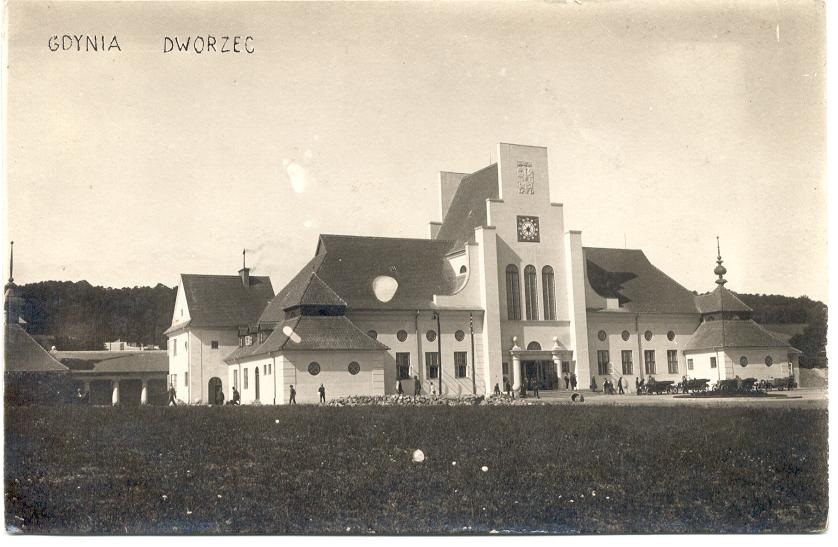
The old railway station in Gdynia (1926), built in the national-manor style (photo: Wikimedia/public domain)
The vision of the nation proposed in these styles was formed by a normative model of Polishness invoking a heroic vision of the past with the figures of kings and commanders, the manorial mentality and the dominance of the Catholic faith.
Despite the ethnic and religious diversity of the pre-partition Polish-Lithuanian Commonwealth (which was also home to, among others, Lithuanians, Rusyns, Cossacks, Jews, Armenians and Tatars, as well as Poles), this was not reflected in the national styles. These saw the nation as a uniform structure deriving from noble manors, whose eternal traditions were to be preserved in the everyday life of simple and backward peasants not tainted by the development of modernity.
In the early 19th century, it was Romanticism that added the role of folklore – of culture and customs as carriers of national memory – to this normative and lordly vision of Polish nationhood.
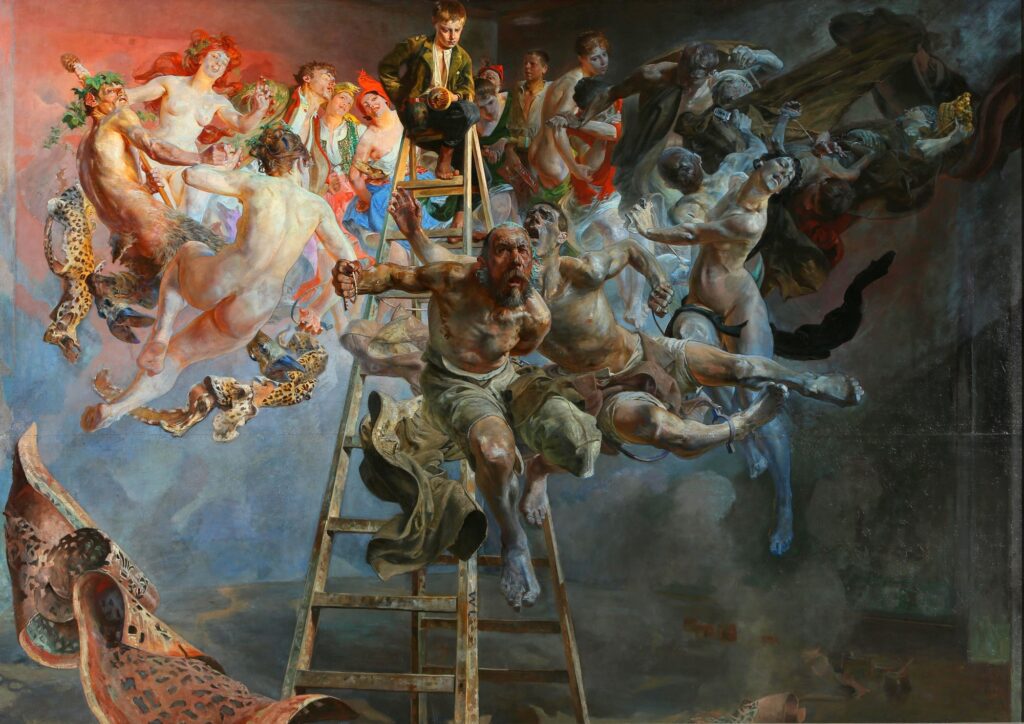
Vicious Circle by Jacek Malczewski, 1895-7 (Muzeum Narodowe Poznań/public domain)
The folk religiosity emerging from centuries of tradition, straightforwardness and hospitality was affirmed. Against this background, the aspirations of artists associated with Young Poland stand out. Their art, deriving from yearning for freedom, youth and newness, was also rooted in national questions.
Its main exponents were students of Jan Matejko, the father of Polish historical painting and eulogist of the historical greatness of the Commonwealth. Matejko was an extremely important figure in 19th-century Kraków, a teacher at its Fine Arts School and the creator of iconic works featuring episodes from Polish history.
His paintings portraying the victories of the Commonwealth, such as The Battle of Grunwald, The Prussian Homage and Constitution of 3 May 1791, came from a profound sense of mission to spread national memory.
Matejko’s pupils, the generation of painters reaching artistic maturity in the 1870s, took on this mission, but opted for other forms. The art of Jacek Malczewski and Stanisław Wyspiański, for example, brought to life spectres from the past, symbols of Poland’s former might and national tragedies, combined with a fascination in folk and native themes.
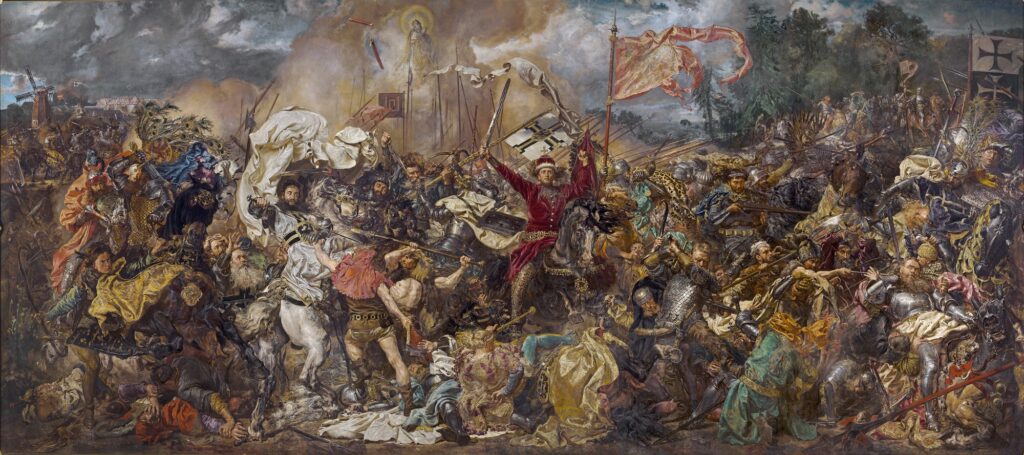
The Battle of Grunwald by Jan Matejko, 1878 (Wikimedia/public domain)
Distinct folk communities such as the Hutsuls and Podhale highlanders, characterised by a coherent material culture, also played a key role in inspiring national styles.
The Hutsuls are a people made up of shepherds living in the Eastern Carpathians, in an area that until 1939 was part of Poland and is now in Ukraine. Famous for their rich, colourful clothing as well as their own music and dances, they were an inspiration for poets and painters around the turn of the 20th century. The Hutsul lands were important in the emergence of the national style, both as a theme in painting and also in craft and architecture.
One of the first painters to portray Hutsul rituals was Teodor Axentowicz. His Feast of Jordan depicts a water sanctification ceremony that took place to remember the baptism of Jesus. It was celebrated on Epiphany, which in the Greek Catholic rite falls on 19 January, with a procession to an ice hole on a frozen river.
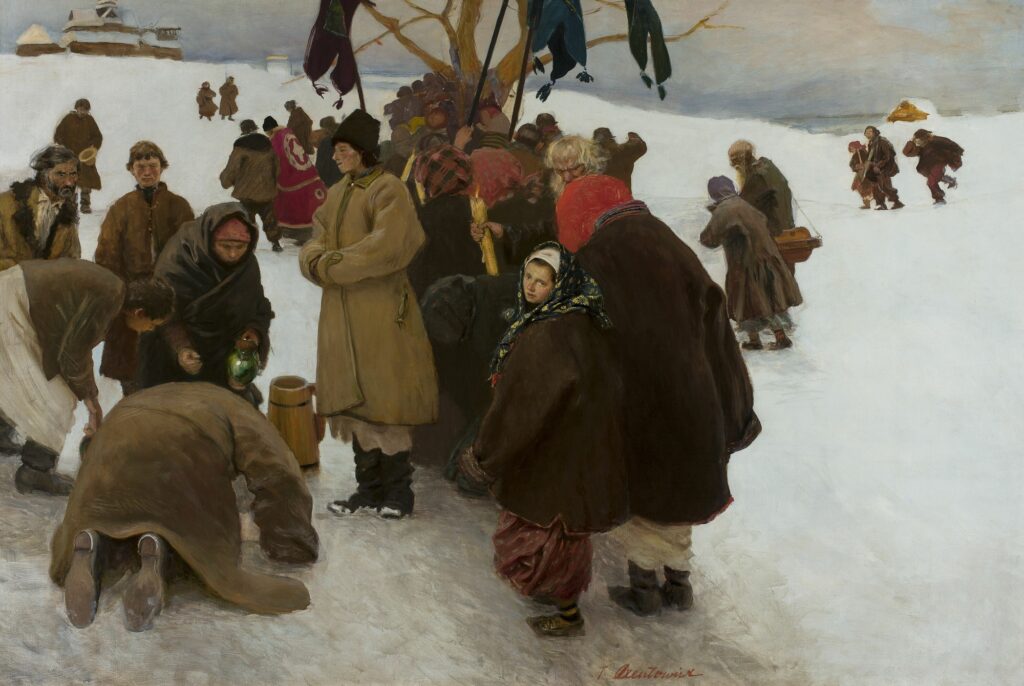
Feast of Jordan by Teodor Axentowicz, 1895 (Muzeum Narodowie w Warszawie/Public domain)
The water was sanctified by immersing a cross in it, before the congregation collected it in small containers and washed their faces. Studies by ethnographers including Oskar Kolberg also contributed to public knowledge on the Hutsuls.
Zakopane became a fashionable spa town in the 1890s. This, along with the increasing popularity of the Tatra mountains, led to a rise in the number of new residents, mostly from nearby Kraków. One was the artist and critic Stanisław Witkiewicz, who sought inspiration in Podhale’s crafts and architecture in his efforts to create a typically Polish style. In his view, the people “preserved traces of some distinct, unique forms of beauty”.
The Zakopane style was formed on the basis of forms of this folklore. The first work was the Koliba villa, commissioned by Zygmunt Gnatowski, a wealthy landowner from Ukraine. The style soon become popular among the intelligentsia staying in Zakopane and was used in further orders of private villas, soon also filtering through into the architecture of guesthouses and spa facilities.
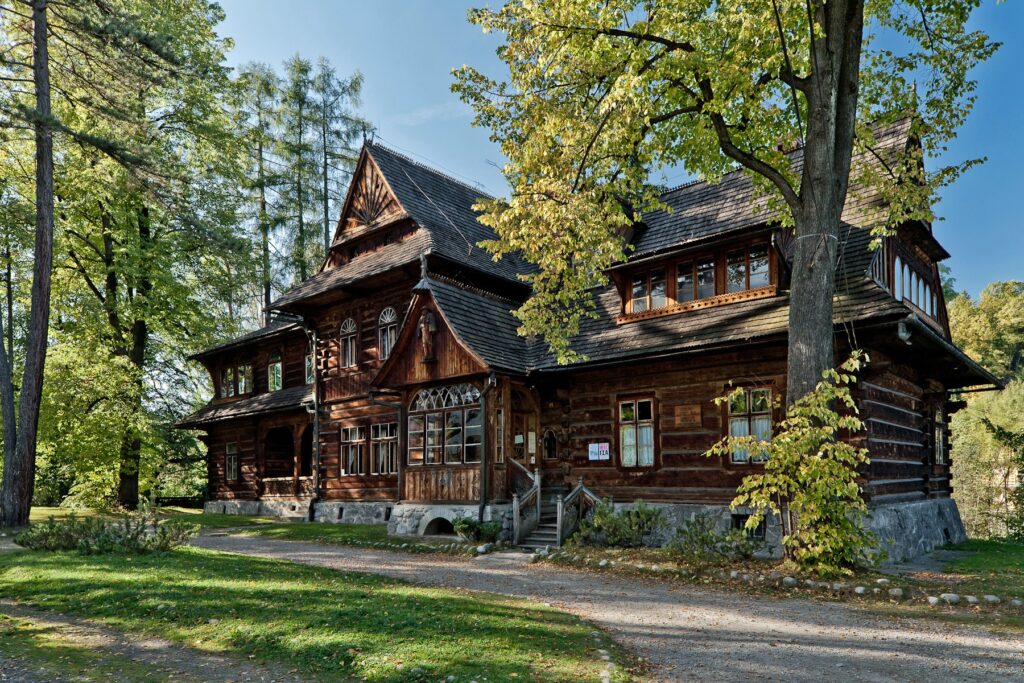
The Koliba villa in Zakopane, now the Museum of the Zakopane Style (photo: Piotr Rekwas/Wikimedia under CC BY-SA 3.0 PLN)
Despite the common belief that the Zakopane style reflects indigenous Polish elements preserved by Podhale folk art, it is important to emphasise that it was an entirely autonomous construct produced by a designer who adeptly combined the traditions of Podhale craft with the demand for a new type of grand bourgeois house erected in Zakopane for wealthy spa visitors.
The Zakopane style was also used to produce furniture, farming equipment, clothing, porcelain items, musical instruments and keepsakes. Elements of the highlander culture also seeped into the work of composers and writers.
Polish inspirations from folklore coincided with a revival of interest in handicraft in Europe, especially with the activity of the Arts and Crafts movement in the British Isles.
**Exhibition news** Young Poland: An Arts and Crafts Movement (1890 – 1918) is the first major exhibition to explore the decorative arts and architecture of the Young Poland (Młoda Polska) period. Opens 9 October https://t.co/786E4sPNoU pic.twitter.com/dpTPdFpUVt
— WilliamMorrisGallery (@WMGallery) August 19, 2021
In Poland, the Polish Applied Art Society was formed in 1901 on the initiative of artists mostly belonging to the young Poland movement, and a decade later the Kraków Workshops brought together exponents of applied arts and more. Aiming to create craft that was both modern and national, they designed fabrics, ceramics, posters and furniture.
The folk tradition also inspired designs and decorations of functional objects. One artist was the painter Zofia Stryjeńska, who also designed toys and print portfolios. In her series of paintings Pascha, she combined religious iconographic motifs with an element of folk culture.
The artist created scenes interweaving various elements: a biblical story, the realities of Polish life, folk motifs, as well as peasant and noble costumes. Pascha also has symbolic value, as it represents the history of Poland’s regaining of independence in 1918.
The concept of creating a national style to be a conscious carrier of patriotic and nationalistic ideas was essentially utopian. It assumed that the Polish nation was and remains culturally homogeneous, disregarding the presence and contribution of all the minorities that for centuries were part of the Polish-Lithuanian Commonwealth.
The only “true Poles” were the “descendants of the Sarmatians”, the Catholic nobility, contrasted with the Jewish and Protestant burghers and the Orthodox Christian or Catholic peasants. Folklore was used solely as a treasure trove of eternal Polish values, untainted by the transformations of modernity.
The exhibition Polish National Styles 1890–1918 is undoubtedly important for understanding both the situation of Poland divided between the three partitioning powers and Poles’ contemporary perception of their national distinctness. Many of the elements of style developed in the period the exhibition presents are today inextricably associated with “Polishness”.
The paintings and functional objects created at the time with elements of folklore are widely regarded as being quintessentially Polish. Even though today they are seen to embody everlasting Polish tradition, it was the patriotic needs of 19th-century artists and theoreticians that led to their “production”.
Translated by Ben Koschalka
Main image credit: Hutsul’s dance in Kołomyjka by Teodor Axentowicz, 1895 (Muzeum Narodowie w Warszawie/Public domain)
